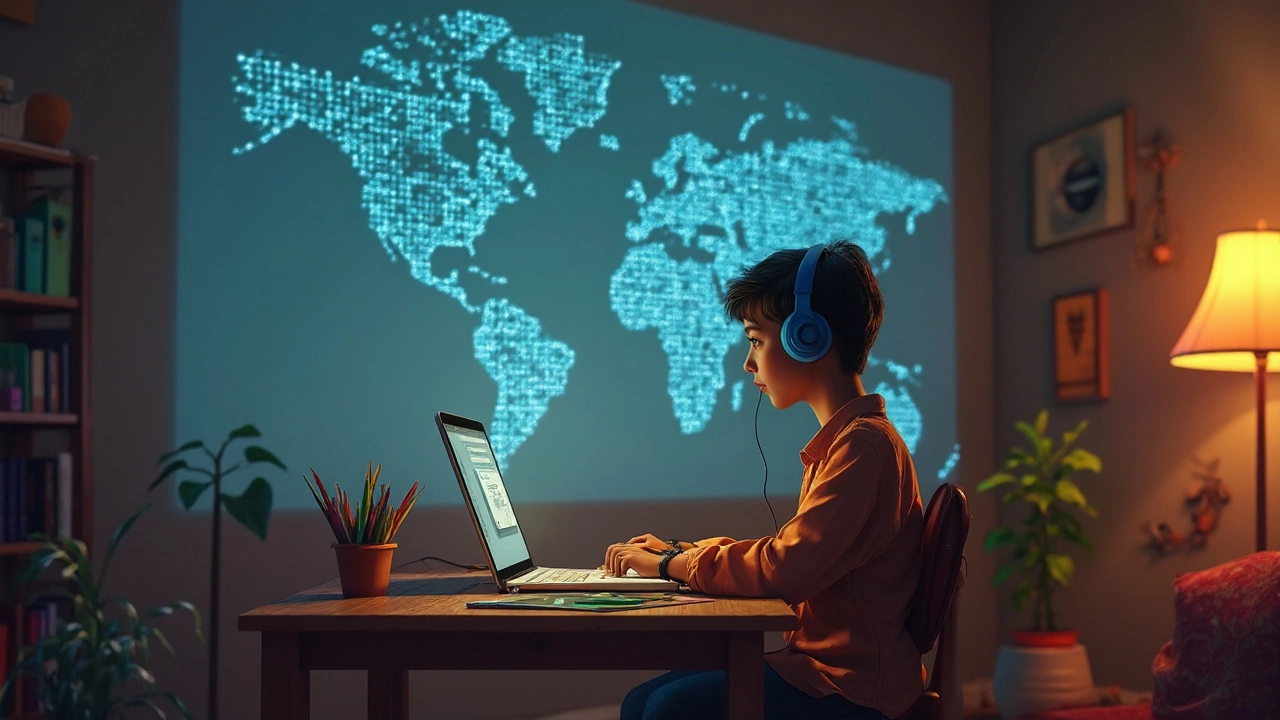So, how does distance learning work? Imagine going to school but skipping the commute. You just whip out your laptop, and bam! You're in class. Sounds nifty, right? This isn't just a dream for tech junkies. It's happening now, and it's changing how education works big time.
At its core, distance learning is all about accessing education from, well... any distance. Thanks to the internet, students can join courses from across the globe. We're not just talking about turning in assignments online. It's about real-time classes, discussions with peers, and even virtual labs. Cool, huh?
To make this all tick, you need some tools. A decent device, a stable internet connection, and probably Zoom or something similar. These platforms have become the unsung heroes of online education, making face-to-face interaction possible without anyone leaving their sofa. But that's just the beginning. There's more going on under the hood to keep this engine running smoothly.
- Introduction to Distance Learning
- Tools and Platforms You Need
- Scheduling Your Study Time
- Common Challenges and Solutions
- Tips for Success in Virtual Learning
Introduction to Distance Learning
Distance learning, or as some folks call it, online education, has really picked up steam, especially since the pandemic hit a few years back. But it's not just a stopgap solution anymore. Nope! It's a legit way to learn, offering flexibility and access to courses that you might not find locally. Imagine taking a class from a top-notch university across the world without leaving your bedroom. That's the magic of e-learning.
Essentially, distance learning takes the traditional classroom setup and flips it on its head. You get to learn through video lectures, online discussions, and digital assignments. The kicker? It all happens over the internet. Some programs run live sessions where you can interact with professors and classmates in real-time, while others might let you go at your own pace, downloading materials and watching pre-recorded videos when it suits you.
One of the biggest perks? Flexibility. With distance learning, if you’re working a hectic job or managing family commitments, you don’t have to miss out on education. You get to fit classes around your life, not the other way around. This format also allows access to resources 24/7, making it easier to review materials and catch up if needed.
Plus, let’s talk geography. You aren’t bound by where you live. Fancy a course that’s only available in a different country? No problem. The world is your oyster when it comes to virtual classrooms. And, whether you're a night owl or an early bird, there's room for all kinds of learning schedules.
Distance learning is not just for college kids either. Professionals looking to upskill while holding down a job can find advanced courses tailored just for them. Schools and universities worldwide are embracing this model, tailoring programs to meet diverse needs.
If you're wondering about stats, here’s a fun fact: By 2025, the online learning industry is estimated to be worth over $350 billion. That's a lot of folks tuning in from around the world!
Tools and Platforms You Need
Diving into distance learning might seem like stepping into a gadget-filled wonderland, but it’s simpler than you think. The key to thriving in this virtual setup is knowing your gear and platforms. Let's break it down.
First up, a reliable device. Most folks stick with a laptop or desktop because they pack enough power for those heavy-duty tasks. Tablets and even smartphones can pinch-hit in a pinch, but they might not give you the full classroom vibe.
Next, the lifeline of online education: a solid internet connection. Trust me, nothing’s worse than getting booted mid-lecture. Aim for at least 5 Mbps for a smoother stream and if possible, go wired over Wi-Fi for better stability. It’s a game-changer.
Now onto the platforms. Zoom and Google Meet are the rockstars for video classes. They keep you face-to-face with teachers and classmates. Need to turn in that essay or collaborate on a project? Google Classroom and Microsoft Teams got you covered with their features like file sharing and group chats.
- Zoom: Best for video conferencing, breakout rooms for group work.
- Google Classroom: Great for assignments, announcements, and everything in between.
- Microsoft Teams: Handy for chat, video calls, and collaborative projects.
- Moodle: Popular for its learning modules and flexible resources.
If you're a stats person, check this out:
| Platform | Best For |
|---|---|
| Zoom | Live lectures |
| Google Classroom | Course management |
| Microsoft Teams | Team collaboration |
| Moodle | Course content delivery |
Setting up is easier than assembling flat-pack furniture. Just download the apps you need, follow the on-screen steps, and you’re in business. Got headphones? They help make sure you hear every word your instructor says—plus they keep you focused.
In distance learning, the right mix of tools and platforms lets you master your coursework from anywhere. Just remember to explore a bit to see which fits your style best. Happy learning!

Scheduling Your Study Time
Getting the hang of distance learning is like mastering a new game level. Timing is everything, especially when your classroom is now your bedroom or kitchen. So how do you nail it?
First off, treat your online classes like real appointments. Mark them in your calendar or set reminders on your phone. This builds a routine, and trust me, routine is your best mate when schooling from home.
Next, figure out your peak study times. Are you a morning person or a night owl? Use these windows to tackle your most challenging coursework. A lot of folks find bits of time here and there but making a real schedule boosts productivity like you wouldn't believe.
Then, there's the golden 25-5 rule, also known as the Pomodoro Technique. It involves 25 minutes of focused work followed by a 5-minute break. After four rounds, take a longer break, like 20-30 minutes. This keeps your brain fresh and ready to rock.
- Online education tends to blur the lines between school and chill time. So, set boundaries. Decide when to switch off schoolwork each day to recharge.
- Use virtual classroom tools like Google Calendar or Trello to plot out your tasks and deadlines. They aren't just handy; you'll feel like an organisational wizard.
- Remember, balance is key. Include time for hobbies, exercise, and socializing, even if it’s just virtual hangouts.
Stats show that having a regular schedule can improve academic performance by up to 20% (no joke). So, while it might be tempting to be a maverick learner, sticking to a schedule could be your secret weapon in acing e-learning.
Common Challenges and Solutions
Diving into distance learning might feel like being tossed into the deep end without a floatie. Trust me, I've heard all sorts of struggles from online learners. But hey, every problem has a fix, right?
One of the biggies is the old friend, procrastination. Without a teacher breathing down your neck, it’s easy to shove that essay ‘til tomorrow. What's the trick? Create a solid routine. Stick to it like glue—a specific time for class, a specific time for study. Use digital planners or good ol' sticky notes to keep track. Trust me, ticking off a task feels so satisfying.
Another issue is feeling isolated. Sure, you’re home, but sometimes it might feel like you’re the Only Person On Earth. Break this by actively engaging in class discussions and group chats. Platforms like Discord or even good ol' WhatsApp can be lifesavers to stay connected with classmates. No need to eat lunch alone while studying solo!
Spotty internet is like that unreliable friend who shows up late to the party. A stable connection is key. If you're struggling with Wi-Fi, try using a mobile hotspot as a backup. Also, many courses allow you to download material offline, so grab that before your next stormy day.
Tech issues? Ugh, we’ve all been there. Make sure you've got a good antivirus and keep your tech updated. If you’re not tech-savvy, there are tons of tutorial videos on YouTube to walk you through. Don't be afraid to reach out for help; there's always someone willing to lend a hand.
Lastly, keeping motivated when the couch and Netflix are just a few steps away can be tough. Create an inviting study space. A tidy desk, maybe a few plants, and some natural light can go a long way in making you want to sit and work.
E-learning brings flexibility but also requires some discipline. Embrace the community, use the tools available, and you’ll find yourself not just surviving, but thriving in your virtual classroom.

Tips for Success in Virtual Learning
Nailing distance learning isn’t just about booting up your computer and showing up. It takes a bit of effort and some smart strategies. Let’s dive into some straightforward tips that’ll make virtual education work like a charm for you.
First up, make a routine. Yep, even though you’re learning from home, sticking to a schedule can save you from the chaos. Set specific times for studying, breaks, and assignments. It doesn't need to be rigid, but it needs some structure—consistency helps keep distractions at bay.
Speaking of distractions, setting up your study space is crucial. Find a quiet corner, pile up your essential tools like notebooks, pens, and keep a charger handy. This isn’t some fancy office setup; even a small table can work wonders if it’s dedicated just for your learning.
Here's a tip: take advantage of the tech. Most online education platforms have features you might be overlooking. Use tools like discussion forums to chat with classmates. Maybe even set up a virtual study group; it's like the group projects, minus the awkward silences.
Feeling overwhelmed is normal, but don't stay stuck. Use the resources available—video tutorials, forums, or even reach out to your teacher via email. Remember, they're there to help, not to haunt.
Stay accountable. Goal setting isn’t just motivational fluff; breaking down tasks into chunks makes them manageable. You might want to track your progress with simple checklists or apps. Celebrate small wins—like finishing a module or acing a quiz.
Take breaks. It sounds counterproductive but trust me, sitting too long can zap your energy. The Pomodoro technique is a hit here—study for 25 minutes, then take a 5-minute breather. It's like giving your brain a quick jog around the block.
Finally, don't forget about networking. Yes, it’s possible even online. LinkedIn groups or community forums related to your field of study can open up opportunities for collaboration or internships.
By embracing these tips, you're not just surviving virtual classrooms but thriving. Remember, each step you take helps you master the art of e-learning, turning it into an enriching educational voyage rather than just clicking through screens.
